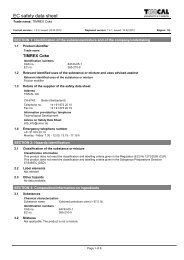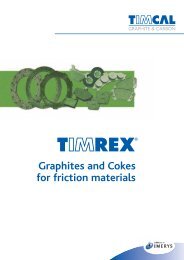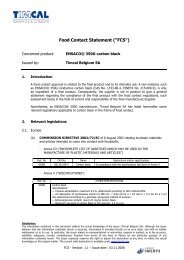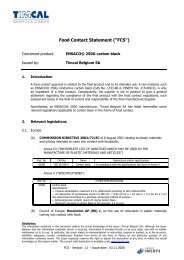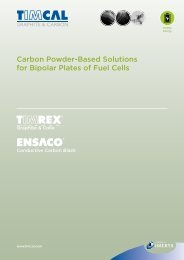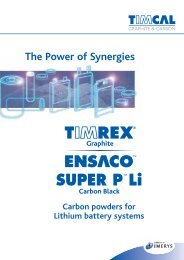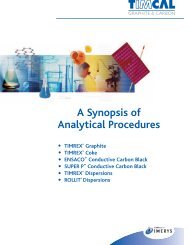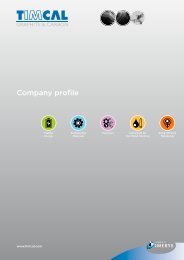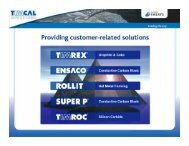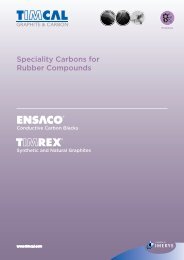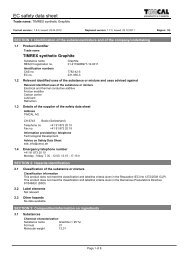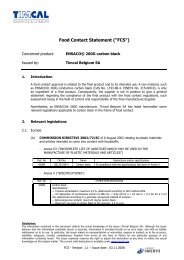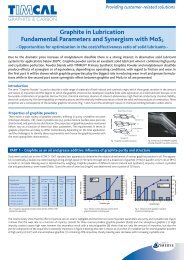Carbon Black Users Guide - Timcal
Carbon Black Users Guide - Timcal
Carbon Black Users Guide - Timcal
Create successful ePaper yourself
Turn your PDF publications into a flip-book with our unique Google optimized e-Paper software.
General InformationWHAT IS CARBON BLACK?<strong>Carbon</strong> black [C.A.S. NO. 1333-86-4] is virtuallypure elemental carbon in the form of colloidalparticles that are produced by incomplete combustionor thermal decomposition of gaseous or liquidhydrocarbons under controlled conditions. Itsphysical appearance is that of a black, finely dividedpellet or powder. Its use in tires, rubber and plasticproducts, printing inks and coatings is related toproperties of specific surface area, particle size andstructure, conductivity and color. <strong>Carbon</strong> black isalso in the top 50 industrial chemicals manufacturedworldwide, based on annual tonnage. Currentworldwide production is about 18 billion poundsper year [8.1 million metric tons]. Approximately90% of carbon black is used in rubber applications,9% as a pigment, and the remaining 1% as an essentialingredient in hundreds of diverse applications.Modern carbon black products are direct descendantsof early “lamp blacks” first produced by the Chineseover 3,500 years ago. These early lamp blacks werenot very pure and differed greatly in their chemicalcomposition from current carbon blacks. Since themid-1970s, most carbon black has been producedby the oil furnace process, which is most oftenreferred to as furnace black.HOW IS IT PRODUCED?Two carbon black manufacturing processes (furnaceblack and thermal black) produce nearly all of theworld's carbon blacks, with the furnace black processbeing the most common. The furnace black processuses heavy aromatic oils as feedstock. The productionfurnace uses a closed reactor to atomize the feedstockoil under carefully controlled conditions (primarilytemperature and pressure). The primary feedstock isintroduced into a hot gas stream (achieved by burninga secondary feedstock, e.g., natural gas or oil) whereit vaporizes and then pyrolyzes in the vapor phaseto form microscopic carbon particles. In most furnacereactors, the reaction rate is controlled by steam orwater sprays. The carbon black produced is conveyedthrough the reactor, cooled, and collected in bagfilters in a continuous process. Residual gas, or tailgas, from a furnace reactor includes a variety of gasessuch as carbon monoxide and hydrogen. Mostfurnace black plants use a portion of this residualgas to produce heat, steam, or electric power. (SeeFigure 1. Typical Furnace <strong>Black</strong> Process Diagram.)Figure 1. Typical Furnace <strong>Black</strong> Process DiagramOIL PREHEATERCogen or EnergyRecovery/Flareoilairwaste gasPELLETIZERwaternatural gasor tail gasREACTORnatural gasAIRPREHEATERBAG FILTERWASTE GASCOMBUSTORDRYERBULKSTGRAILROAD CARS TRUCKS BAGS SUPER SACKS



